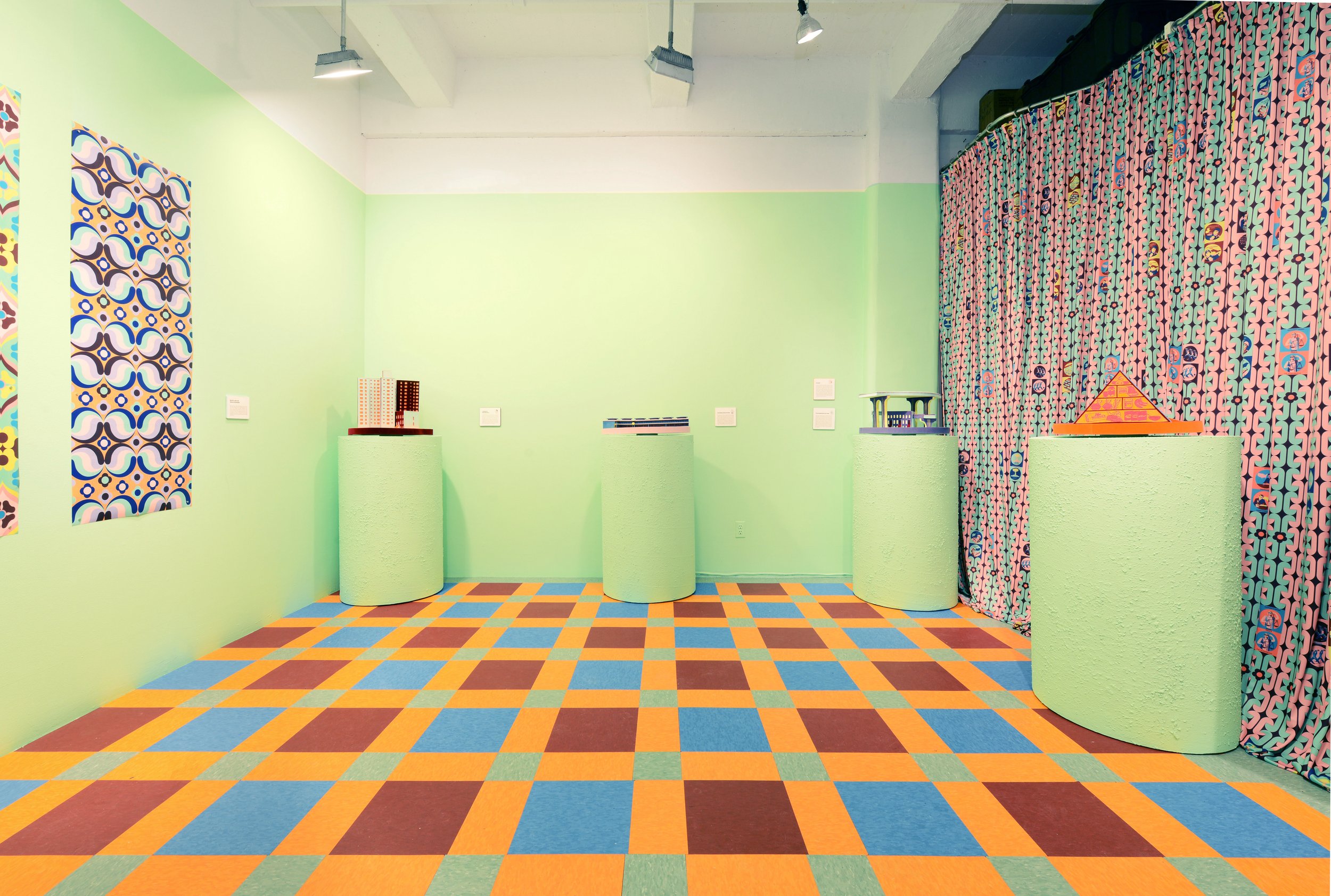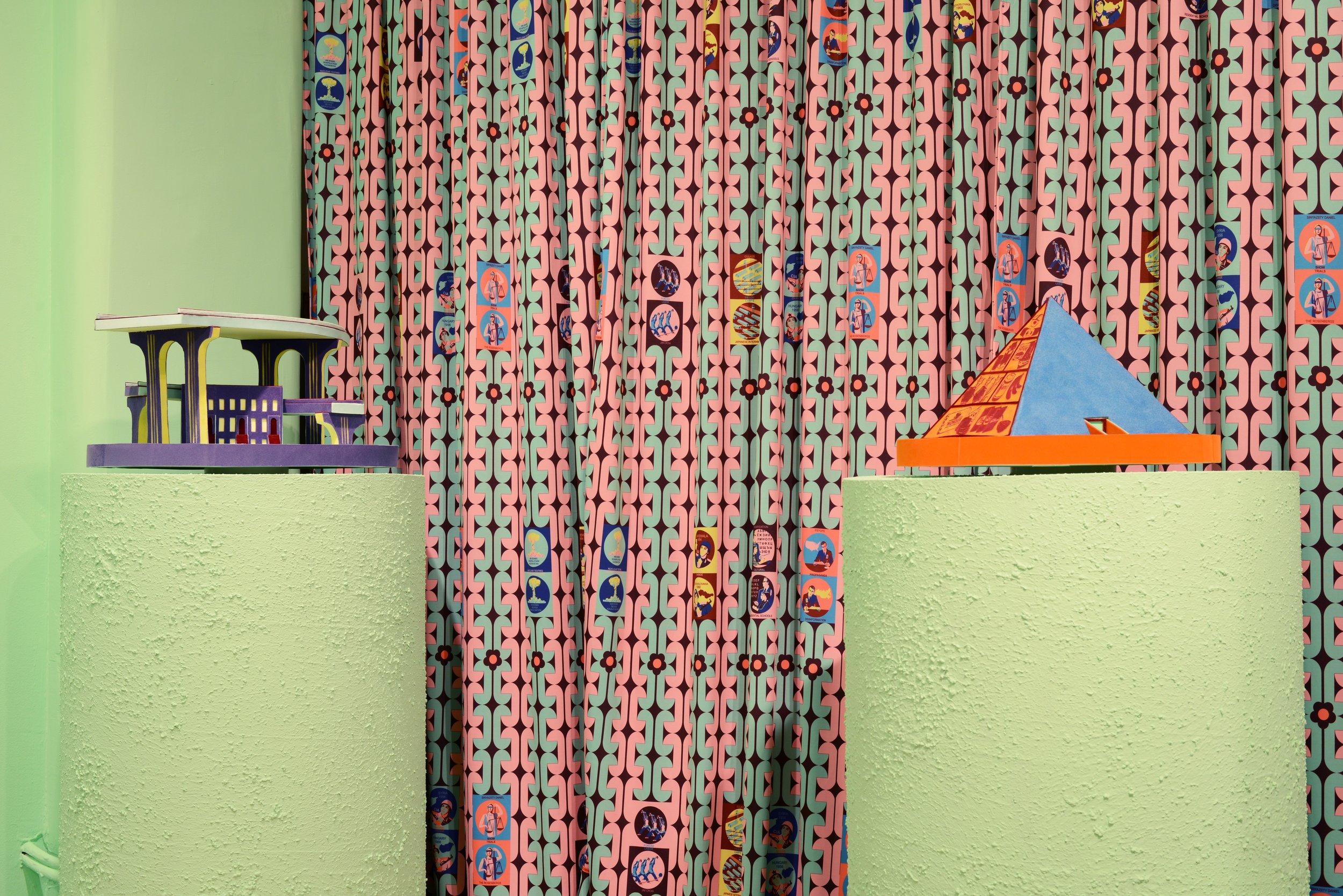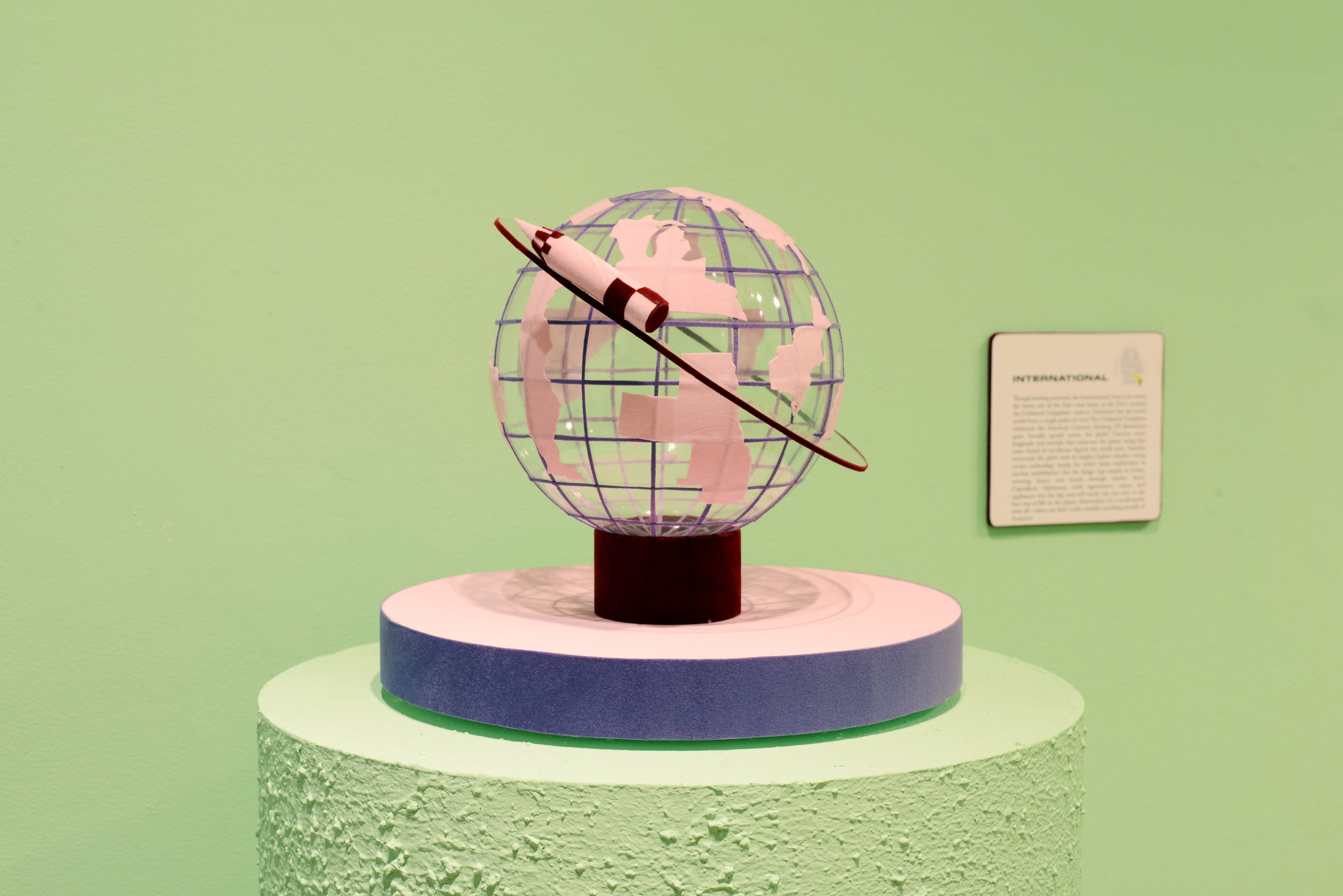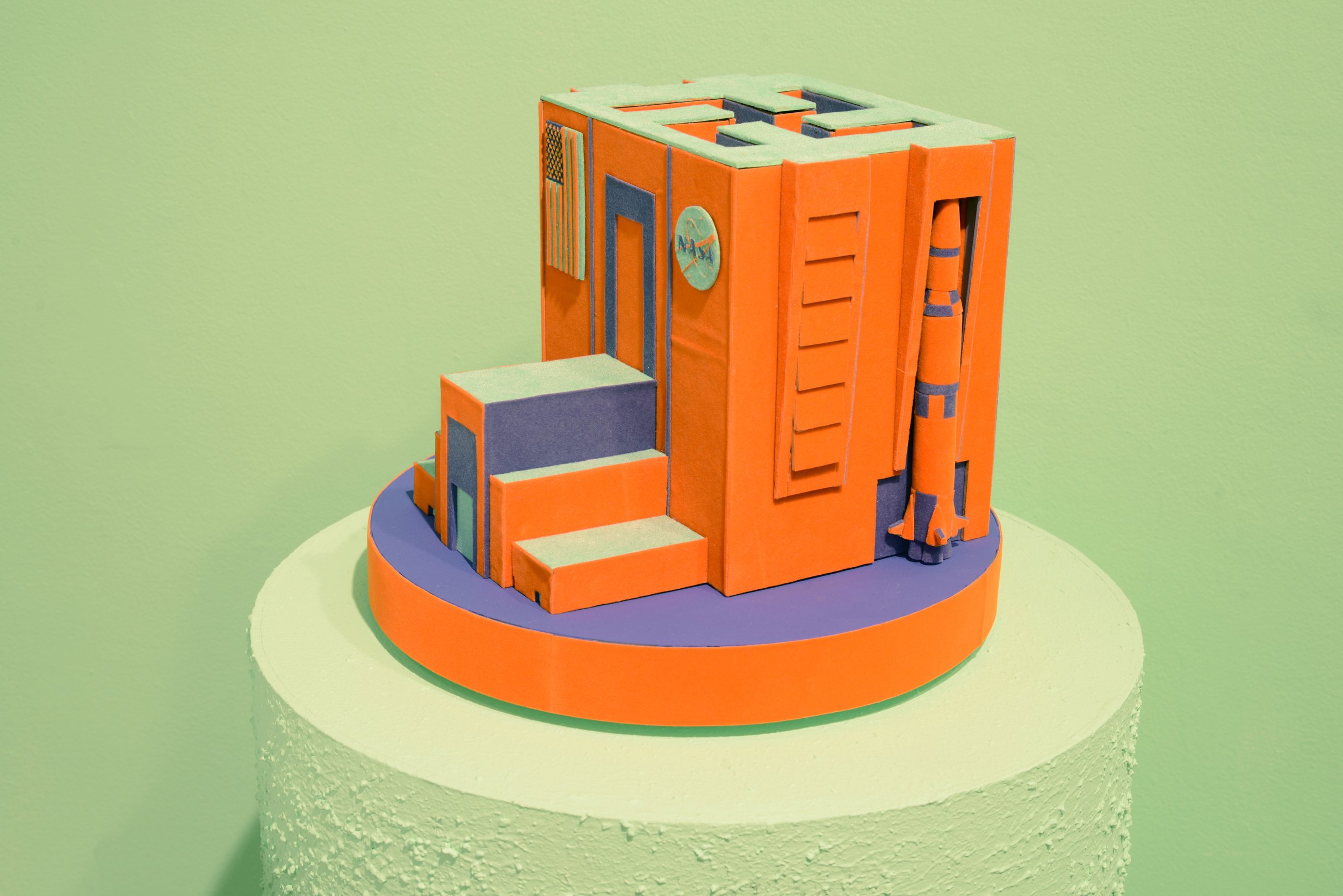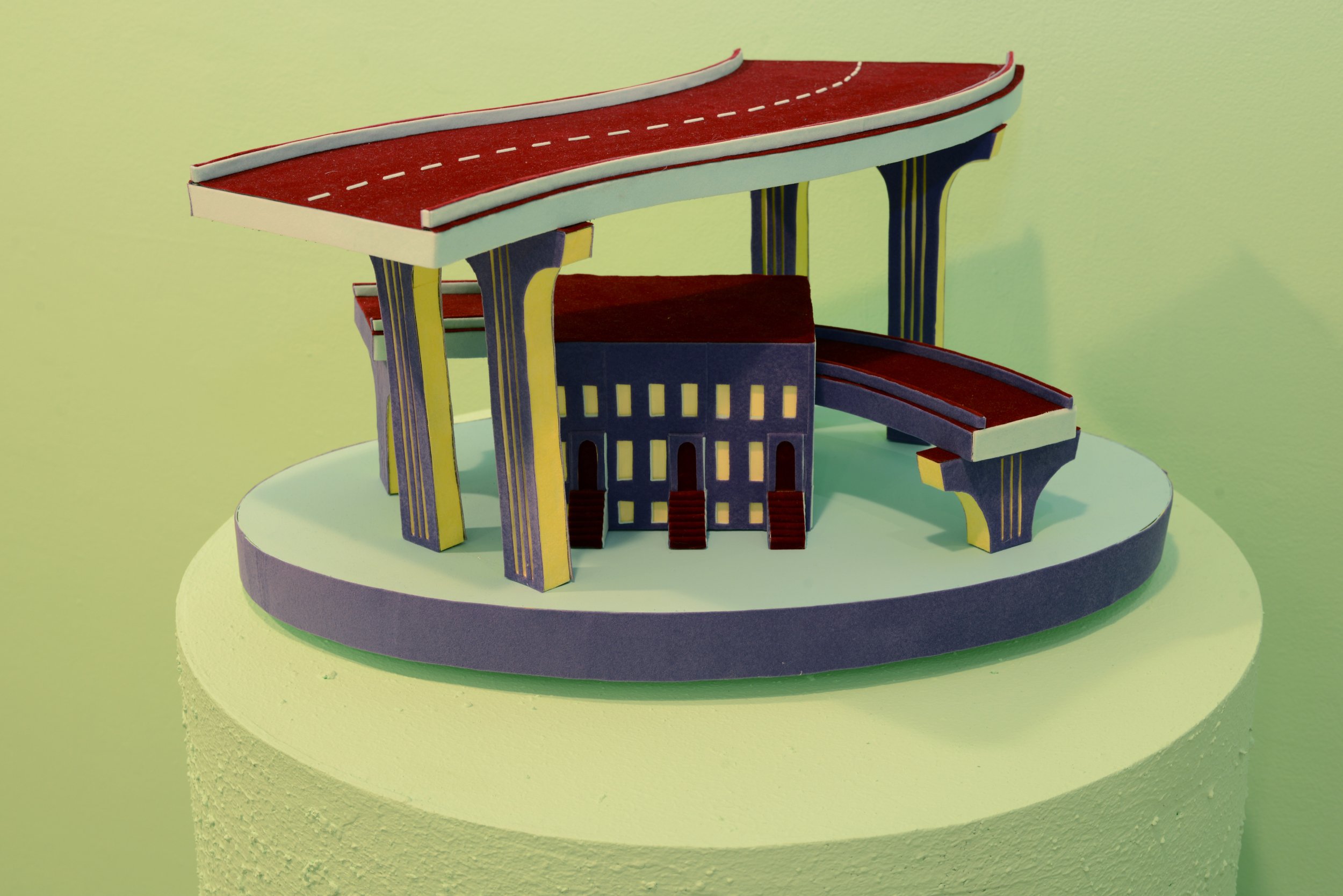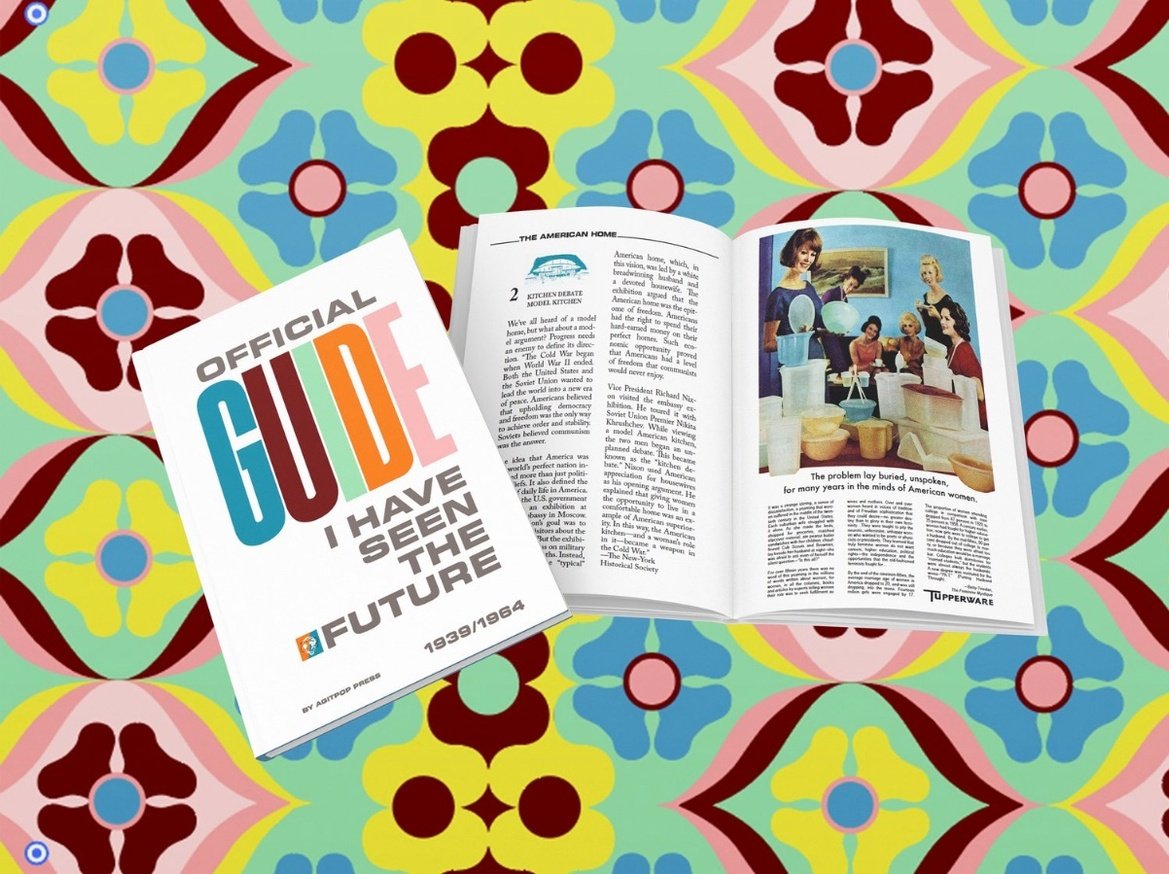
I Have Seen the Future
2022 | Field Projects | New York, NY
Twenty-five years apart, on the precipice of World War and at the height of the Cold War, two World’s Fairs were held in Flushing Meadows, Queens.
Through a sensibility that emphasizes intersectionality, interconnectedness, and correlation, "I Have Seen the Future" is an immersive exhibition that looks back at how visions of utopia of 1939 and 1964 have defined our reality in the 21st century. All art objects in the show (7 flocked architectural models, 2 embossed swaths of wallpaper, a digitally printed curtain and a guidebook) and installation strategies (institutional green wall paint, printed wall didactics, textured plinths with embedded motors that continuously spin each model around, and linoleum flooring) are meant to evoke the experience of visiting the '64 World’s Fair, with the hindsight of 2022.
Pavilions
As part of the exhibition "I Have Seen the Future," the reimagined World's Fairgrounds are organized into 7 themed areas, each represented by flocked architectural model of the area's main "pavilion." Each model hacks the form of an existing architectural structure to reference a historical event or precedent of State violence during the mid-century.
Science & Education Pavilion (Operation Paperclip)
2022, 10in x 12in x 10in, nylon flocking, chipboard, acrylic, bristol
The original '64 Fair was saturated with the space race--from the Fair's Googie architecture to the display of actual Gemini space crafts as well as pavilions by companies such as Dow and Monsanto who were involved in technological developments crucial to both the space and arms race with the Soviet Union. However these scientific developments in the US were aided by hiring 1600+ former Nazi scientists through a program known as Operation Paperclip. These war criminals would both start NASA and help Dow and Monsanto invent Napalm and Agent Orange, respectively. This "pavilion" references that history by embedding a swastika into the roof of the Kennedy Space Center along with th Saturn V rocket designed by former Nazi scientist Wernher von Braun.
Communications Pavilion (Wire-Tapped Lorraine Hotel)
2022, 22in x 4in x 6in, nylon flocking, chipboard, acrylic, bristol
In the original '64 Fair the RCA's Communications Pavilion featured listening stations for stereo and hi-fi enthusiasts. In this reimagined fair the "Communications Pavilion" instead addresses the history of FBI's COINTELPRO program surveilling Civil Rights leaders including Martin Luther King Jr.. Its architectural form references the Lorraine Hotel—where King was assassinated in 1968—topped with FBI wire-tapped tape reels.
Transportation Pavilion (Highways of Displacement)
2022, 23in x 18in x 15in, nylon flocking, chipboard, acrylic, bristol
Auto manufacturers Ford, GM and Chevrolet featured prominently at the original '64 Fair, showcasing America's continued love affair with the automobile. Though he couldn't drive himself, NYC's premier urban planner Robert Moses was also obsessed with building cities suited to cars rather than people—building 627 roads in New York City over his tenure which would displace over 100 thousand people (mostly low-income BIPOC) and destroy dozens of neighborhoods along the way. This "pavilion" references the complete destruction of the Bronx's East Tremont neighborhood, which displaced more than 1500 families to build the Cross-Bronx Expressway.
The American Home Pavilion (Suburban Jubilee)
2022, 10in x 9in x 7in, nylon flocking, chipboard, acrylic, bristol
The mythologizing of American domestic life—suburban housewives, the nuclear family home, and the plethora of consumer goods that accompanied it—was used as an effective weapon in the Cold War. From the late ’40’s through the ‘60s the US held numerous international expos to showcase American consumer products—goods that came in a dazzling array of colors and were markedly absent from Soviet homes. Yet the reality of the suburbs in the US was that this domestic bliss was strategically segregated—many homes even having racially restrictive covenants baked into their deeds. This “pavilion” takes its architectural form from the Jubilee model of the Levittown home (America’s first suburban development), surrounded by an oversized segregationist white picket fence.
Food Pavilion (Food Pyramid Scheme)
2022, 10in x 11in x 10in, nylon flocking, chipboard, acrylic, bristol
This ‘pavilion’ literalizes the Food Pyramid into an architectural form, referencing the corporate control that Big Food would start to have over the American diet in the post-war years. Earlier versions of nutritional guides became being disseminated in public school home economics classes in the 1940s and while purporting to be guides on a healthy diet, such didactics were guided more by grain and dairy lobbyists than they were dietary science. This reimagined pyramid incorporates high-sugar cereals, Wonderbread, Tang, high-fructose corn syrup, Twinkies, and SPAM—all highly processed (non-nutritional) staples of the mid century American diet. The opposite side of the pyramid features text detailing the 4 ways in which Big Food built control over the American diet: co-opting regulators and legislators, financing “shadow” groups and industry-friendly scientists, litigating against food regulations, and blocking consumer litigation.
Urban Renewal Pavilion (The Violence of Utopia)
2022, 23in x 22in x 18in, nylon flocking, chipboard, acrylic, bristol
The design takes the architectural form of the LES’s Jacob Riis Housing (though exact or similar designs were using in public housing throughout the city) stamping out a row of brownstones. Such massive public housing complexes were championed by Robert Moses (emulating his idol Corbusier) and created by destroying vast swaths of neighborhoods to create “super blocks.” Such super block complexes would both radically disrupt the community structure and street culture of the neighborhoods they displaced, and strategically perpetuate segregation—creating well-maintained exclusive high rises for whites (like Stuytown) and overcrowded, poorly maintained high rises for BIPOC.
International Pavilion (Unilateral Unisphere)
2022, 9in x 11in x 9in, nylon flocking, chipboard, acrylic, bristol
This “pavilion” takes the form of the U.S. Steel unisphere from the 1964 World’s Fair as a model, but rather than presenting the entire globe, the United States is broken up and scattered about the planet, as a physical manifestation of American Exceptionalism. In this unilateral planet’s orbit is the Saturn V rocket, designed for NASA by Arthur Rudolph. Rudolph was a Nazi scientist who personally oversaw torture; he was brought to the US after WWII along with 1,600 other Nazi scientists part of Operation Paperclip.
I Have Seen the Future: Official Guide
2022, 4.75in x 7.5in x .25in, 175 page perfect bound book, open edition
Publication in collaboration with writer Cara Marsh Sheffler. The guide subverts the format of the 1964 World's Fair Guide—using critical essays, subverted advertisements and appropriated imagery from the era—to expand on the research behind each of the 7 themed Fair areas. By pairing critical text with nostalgic, often wacky 1960's imagery, the reader is unassumingly guided through a litany of dark mid-century histories, exploring US state-sanctioned violence in the guise of enthusiastically advertised World's Fair attractions.
Preview excerpt / Buy here
